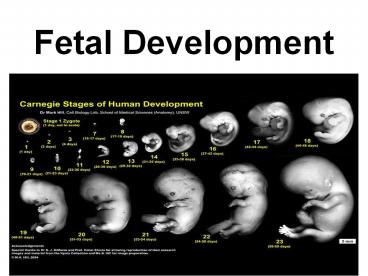Fetal Development - PowerPoint PPT Presentation
Title:
Fetal Development
Description:
Liver is now about 10% of body and is the main blood forming organ Diseases my effect development such as German measles which affects heart ... the inner ear, ... – PowerPoint PPT presentation
Number of Views:162
Avg rating:3.0/5.0
Title: Fetal Development
1
Fetal Development
2
- First trimestermonths 0-3
- Second Trimestermonths 4-6
- Third Trimestermonths 7-delivery
3
Week 2
- Embryo is about 1.5 millimeters long
- Neural plate appears
4
Week 3
- 2.3 millimeters long
- Has 12-14 somites (embryonic body segments)
- Blood vessels and primitive gut begin to develop
- Begins Most critical weeks of development
5
Week 4
- 5.2 millimeters long
- Increases mass 7,000 times
- Eyes begin forming
- Heart is still a tube but it begins to flutter
and pulsate - Neural groove closes
- Embryo is C-shaped
- Now has 30 pairs of somites
- Muscles, bones, and connective tissue develops
from somites - Arm buds are visible and leg buds begin to form
- By end of week 4, heart develops into four
chambered vessel
6
Month 2
- Embryo increases in mass 500 times and weighs
about 1/30 ounce (1 aspirin) - About 1 inch long
- After 2 months, called a fetus
- Arms, legs, knees, elbows, fingers, and toes
begin to form - There is a temporary tail that is longest at this
time but gradually disappears . Gone in 94 of
babies by time of birth. - Liver is now about 10 of body and is the main
blood forming organ - Diseases my effect development such as German
measles which affects heart formation, the eye
lens, the inner ear, and brain
7
Month 3
- Around 3 inches long from head to buttocks and
weighs about ½ ounce (15 aspirins) - Fetus is able to move arms and kick legs
- Has reflexes like squinting, frowning
- External sexual organs begin to develop
- Can suck and swallow some of the fluid that
surround the amniotic sac - Kidneys and the other excretory structures
develop - Waste is disposed thru placenta
8
Month 4
- 5 inches long (head to buttocks) and weighs 5
ounces - Bony skull is forming and can be seen by X-ray
- The body is becoming covered by protective,
cheesy coating
9
Month 5
- 7 inches long and weighs ½ lbs. or 8 ounces
- Has hair on head
- Body is covered by fuzzy soft hair called lanugo
- Heart beats 120-160 times /minute
- Youngest child to survive was 23 weeks but
required assisted breathing, feeding, temperature
maintenence
10
Month 6
- 12-14 inches long and weighs 1.5 lbs.
- 90 of fetal weight gain occurs during this time
- At end of 6 months, a fetal typically has a good
chance of survival - Skin is red and wrinkled
- Abundant cheesy body covering
- Can now find pasty green mass of dead cells and
bile called meconium in bowel which stays until
birth - Problem if released early, child is exposed to
bacterial infection especially in lungs - eyes and eyelashes appear
11
Months 7-9
- Doubles in size
- Many nerve tracts are forming and new brain cells
are produced at rapid rates - Protein intake by mother is important because
protein is needed to develop the nervous system
affecting intelligence - At months 8-9 fat is deposited which smoothes out
the wrinkles - Nails project
- Hair coat sheds































